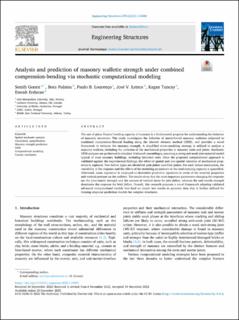| dc.contributor.author | Gonen, Semih | |
| dc.contributor.author | Pulatsu, Bora | |
| dc.contributor.author | Lourenço, Paulo B. | |
| dc.contributor.author | Lemos, José V. | |
| dc.contributor.author | Tuncay, Kagan | |
| dc.contributor.author | Erduran, Emrah | |
| dc.date.accessioned | 2023-10-19T07:14:57Z | |
| dc.date.available | 2023-10-19T07:14:57Z | |
| dc.date.created | 2023-03-17T09:26:13Z | |
| dc.date.issued | 2023 | |
| dc.identifier.citation | Engineering structures. 2023, 278 . | en_US |
| dc.identifier.issn | 0141-0296 | |
| dc.identifier.uri | https://hdl.handle.net/11250/3097414 | |
| dc.description.abstract | The out-of-plane flexural bending capacity of masonry is a fundamental property for understanding the behavior of masonry structures. This study investigates the behavior of unreinforced masonry wallettes subjected to combined compression-flexural loading using the discrete element method (DEM), and provides a novel framework to estimate the masonry strength. A simplified micro-modeling strategy is utilized to analyze a masonry wallette, including the variation of the mechanical properties in masonry units and joints. Stochastic DEM analyses are performed to simulate brickwork assemblages, assuming a strong unit-weak joint material model typical of most masonry buildings, including historical ones. Once the proposed computational approach is validated against the experimental findings, the effect of spatial and non-spatial variation of mechanical properties is explored. Two failure types are identified: joint failure and brick failure. For each failure mechanism, the variability of the response and the effects of the modeling parameters on the load-carrying capacity is quantified. Afterward, Lasso regression is employed to determine predictive equations in terms of the material properties and vertical pressure on the wallette. The results show that the most important parameters changing the response are the joint tensile strength and the amount of vertical stress for joint failure, whereas the unit tensile strength dominates the response for brick failure. Overall, this research proposes a novel framework adopting validated advanced computational models that feed on simple test results to generate data that is further utilized for training response prediction models for complex structures. | en_US |
| dc.language.iso | eng | en_US |
| dc.rights | Navngivelse 4.0 Internasjonal | * |
| dc.rights.uri | http://creativecommons.org/licenses/by/4.0/deed.no | * |
| dc.title | Analysis and prediction of masonry wallette strength under combined compression-bending via stochastic computational modeling | en_US |
| dc.type | Peer reviewed | en_US |
| dc.type | Journal article | en_US |
| dc.description.version | publishedVersion | en_US |
| cristin.ispublished | true | |
| cristin.fulltext | original | |
| cristin.qualitycode | 2 | |
| dc.identifier.doi | 10.1016/j.engstruct.2022.115492 | |
| dc.identifier.cristin | 2134643 | |
| dc.source.journal | Engineering structures | en_US |
| dc.source.volume | 278 | en_US |
| dc.source.pagenumber | 13 | en_US |

